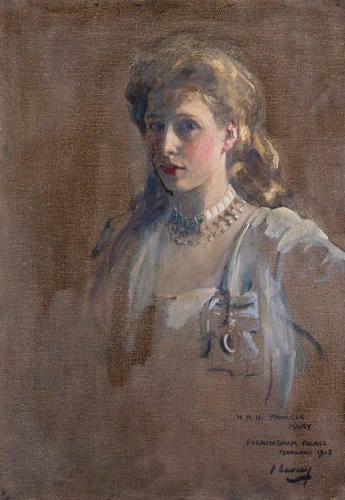Mary, Princess Royal (1897-1965), later Countess of Harewood 1913
Oil on canvas | 76.2 x 53.5 cm (support, canvas/panel/stretcher external) | RCIN 407132
-
This is a single-figure study of Princess Mary for the large royal family portrait in the National Portrait Gallery. Together with a similar study of the Prince of Wales (RCIN 407133), it was presented to Queen Mary by the artist in 1913.
Lavery made four initial single-figure studies for his royal family group portrait: two large ones of the King and Queen, and two smaller ones of the Prince of Wales and Princess Mary. The studies of the King and Queen, also presented by Lavery in 1913, were worked up into independent portraits and widely exhibited. Those of the Prince of Wales and Princess Mary were originally the size of the two group studies but have been slightly reduced.
From Lavery's inscription on this study, Princess Mary must have sat to him in Buckingham Palace in February 1913. She did not record the sittings in her diary but it is likely that she gave several sittings, as did her brother. The Prince of Wales gave two sittings in March of two and one-and-a-half hours; ‘Awful waste of time,' he commented in his diary. The relaxed figure of the seated Princess is important for the finished portrait both compositionally and as a counterpart to the other stiff, upright figures.
Princess Mary the only daughter of George V and Queen Mary was born and brought up at Sandringham House. Educated by governesses, she became fluent in French and German. She greatly enjoyed the outdoor life, acquiring an enduring love of horses and skill in riding. She was later to be painted on horseback by Sir Alfred Munnings.
Of a gentle disposition, the Princess had a beautiful complexion but was often unwell. Lady Maud Baillie, daughter of the ninth Duke of Devonshire and a fellow pupil before the First World War, recorded, 'Princess Mary and I were not great scholars. She was generally miserable with hay fever and terrified of her governess, who sat knitting fiercely like Mme Defarge.' Lady Maud also believed Princess Mary had very limited contact with other children. The Prince of Wales constantly complained to the Queen of his sister's secluded and lonely life; more practically, he suggested possible suitors.
Queen Mary however had her own plans for her daughter's future, wishing her to be married to Prince Ernst August of Hanover, a direct male descendant of George III. It was not to be, for in 1913 Prince Ernst married the German Emperor's daughter. The First World War put paid to further German marital plans, and the Princess married in 1922 Viscount Lascelles, later sixth Earl of Harewood. George V greatly saddened by his daughter's departure, commissioned a large painting by Frank Salisbury of her marriage in Westminster Abbey. Lavery painted her wedding procession in Green Park.
Text adapted from The Quest for Albion: Monarchy and the Patronage of British Painting, London, 1998.Provenance
Presented to Queen Mary by the artist, 1913
-
Medium and techniques
Oil on canvas
Measurements
76.2 x 53.5 cm (support, canvas/panel/stretcher external)
92.5 x 69.5 x 7.0 cm (frame, external)
Category
Object type(s)
Alternative title(s)
Princess Mary (Sketch)
The Princess Royal








